Keio University
[慶應義塾大学] Error: {{Lang}}: text has italic markup (help) | |
| File:Keio Logo.jpg | |
| Motto | Calamvs gladio fortior (Latin: The pen is mightier than the sword) |
|---|---|
| Type | Private |
| Established | 1858 |
| Endowment | N/A |
| Chancellor | Prof. Atsushi Seike |
Academic staff | full time 1,533[1] part time 1,045[2] |
| Students | 32,275 |
| Undergraduates | 27,984 |
| Postgraduates | 4,291 |
| 3,708 | |
| Location | , , |
| Campus | Urban |
| Athletics | 39 varsity teams |
| Colors | Blue and Red |
| Nickname | Unicorns, etc. |
| Affiliations | ASAIHL |
| Website | Keio University |

Keio University (慶應義塾大学, Keiō Gijuku Daigaku),abbreviated as Keio (慶應, Keio) or Keidai (慶大, Keidai), is a Japanese university located in Minato, Tokyo. It is known as the oldest institute of higher education in Japan.[3] Founder Fukuzawa Yukichi originally established it as a school for Western studies in 1858 in Edo (now Tokyo). It has eleven campuses in Tokyo and Kanagawa. It has nine faculties, which cover a wide range of academic fields, with each operating independently and offering a broad educational and research activities. The faculties are: Letters, Economics, Laws, Business and Commerce, Medicine, Science and Technology, Policy Management, Environment and Information Studies, Nursing and Medical Care, and Pharmacy.
The alumni include 3 Japanese prime ministers[4] and prominent corporate leaders. Currently 12 Keio graduates engage as the Fortune Global 500's CEOs.[5]
Overview



Keio traces its history to 1858 when Fukuzawa Yukichi, who had studied the Western educational system at Brown University in the United States, started to teach Dutch while he was a guest of Okudaira family. In 1868 he changed the name of the school to Keio Gijuku and devoted all his time to education. While Keiō's initial identity was that of a private school of Western studies, it expanded and established its first university faculty in 1890, and became known as a leading institute in Japanese higher education. It was the first Japanese university to reach its 150th anniversary, celebrating this anniversary in 2008.
Keio's School of Medicine has long-standing research links with the Harvard Medical School.[6] Keio University has joined the MIT and the French INRIA in hosting the international World W3C.[7] Keio has one of the largest financial endowments of any Japanese university.
In 2009, Keio University was selected as a "Global 30" university, a government program "which is aimed at elevating... international competitiveness among the world's top universities and at creating an attractive environment for overseas students, while fostering students and researchers capable of playing active international roles."[8]
Keio has leading research centers. It has approximately 30 Research Centers located on its five main campuses and at other facilities for advanced research in Japan [9]
Mission
Fukuzawa stated the mission of Keio shown below, which is based on his speach for the alumni's party on November 1st in 1896.[10]
Keio Gijuku shouldn't be satisfied with being just one educational institution.
Its mission is expected to be a model of the nobility of intelligence and virtue,
to make clear how it can be applied to its family, society, and nation,
and to take an actual action of this statement.
It expects all students being leaders in society by the practice of this mission.
Those sentences were given to students as his will, and considered as the simple expression of Keio's actual mission.[10]
Academic culture
Contributor to Japanese modern education systems
Keio is known that it has primarily introduced many modern education systems in Japan. The followings are the examples.
- Keio is the earliest Japanese school that introduced the annual fixed course fee, designed by Fukuzawa.[11]
- It initially introduced the culture of speech to Japan, which Japan had never had before. It built Japan's earliest speech house Mita Speech House in 1875 as well.[12]
- It is regarded as Japan's first university which accept the international students.[13] Keio accepted 2 Korean students in 1881 as its (and also Japan's) first international students. 60 Korean students entered in 1883 and 130 Korean students in 1895.
Dokuritsu Jison
Keio put "Independence and self-respect (独立自尊, Dokuritsu Jison)" as a fundation of its education. This is meant to be physically and mentally independent, and respect yourself for keeping your virtue.[14] Independence and self-respect are also regarded as Fukuzawa's nature and essence of his education.[15]
Hangaku Hankyo
Learning half and teaching half (半学半教, Hangaku Hankyo) is the other unique culture in Keio.[16] During the late Edo period and the early Meiji period, several private prep schools often used students as assistant teachers and it was called "Learning half and teaching half". Keio also had initially used this system. In the early period of such Western learning schools, there had been many things to learn not only for students but also professors themselves. Hence there had been sometimes the occasions that students who had learned in advance had taught other students and even professors. After the proper legal systems for education had been set up, those situations have been disappeared. However, Fukuzawa thought the essence of academia is a continuous learning, and knowing more things provides more learning opportunities. Keio respects his thought and put the rule in "Rules in Keio Gijuku (慶應義塾社中之約束, Keio Gijuku Shachu no Yakusoku)" that there shouldn't be any hierarchy between teachers and learners, and all of the people in Keio Gijuku are just in a same company. For this reason, there is still a culture in this university that All professors and lecturers are officially called with the honorific of "Kun" but never "Teacher" or "Professor".[17][18]
Shachu no Kyoryoku
Collaboration in a company (社中の協力, Shachu no Kyoryoku) is also an uniqueness of Keio.[19] Fukuzawa stated in 1879 that the Keio's success today is because of the collaboration in its company, and "Collaboration in a company" originally came from this article. People in Keio often think that all of the people related to Keio (e.g. professors, students, alumni and their family members) are the part of their company, thus they should try to help each other like brothers and sisters. This culture has been often seen especially in the alumni organization called Mita-Kai.[20]
History
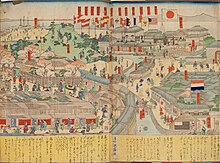

Keio University (慶應義塾大学, Keiō Gijuku Daigaku) was established in 1858 as a Western learning school localted in one of the mansion houses in Tsukiji by the founder Fukuzawa Yukichi.[21] Its root is considered as the Han school for Kokugaku named Shinshu Kan established in 1796.[22] Keio changed its name as "Keio Gijuku" in 1868, which came from the era name "Keio"[23] and "Gijuku" as the translation of Public school.[24] It movied to the current location in 1871, established the Medical school in 1873, and the official university department with Economics, Law and Literacy study in 1890.[25]
Keio has been forming its structure in the following chronological order.[26]
| Year | University development |
|---|---|
| 1858 | Keio Gijuku was established |
| 1879 | It rejected an offer to become a national university. Instead of that, it became a vocational school funded by Daimyos including Shimazu clan. |
| 1890 | University department with Faculty of Economics, Faculty of Law, and Faculty of Letters was set up |
| 1906 | Graduate school was set up |
| 1917 | School of Medicine was set up |
| 1920 | It was authorized as a university in the prewar system |
| 1944 | Faculty of Technology was set up |
| 1949 | It was authorized as a university in the post-war system |
| 1957 | Faculty of Business and Commerce was set up |
| 1962 | Graduate School of Business Administration was set up |
| 1981 | Faculty of Science and Technology (reformed from Faculty of Technology) was set up |
| 1990 | Faculty of Environment and Information Studies and Faculty of Policy Management was set up |
| 1994 | Graduate School of Media Design was set up |
| 2001 | Faculty of Nursing and Medical Care was set up |
| 2004 | Law School was set up |
| 2008 | Faculty of Pharmacy was set up |
There have been several notable things in Keio's over 150 year history as shown below.
- Keio launched Hiromoto Watanabe as a first chancellor of the Imperial University (University of Tokyo) in 1886. He is the first chancellor of the officially authorized university.
- Keio sent 6 students to abroad in 1899. In the same year, it accepted 3 international students from India, Qing Dynasty, and Thailand. 8 international students entered from Taiwan in the next year.
- Keio was visited by Bengali poet Rabindranath Tagore where he made a speech in 1916.
- Keio was visited by Albert Einstein where he presented a lecture on the special theory of relativity in 1922.[27]
- It started to accept female students from 1946.
- A paper written by Keio undergraduate student as the first author was placed in the research journal Science in 2006, which had rarely happened to any undergraduate students.[28][29][30]
- Keio was visited by Prince Charles in 2008.
Athletics
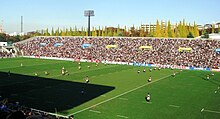
Edward Bramwell Clarke and Tanaka Ginnosuke first introduced Rugby union to Japanese students at Keio University. (The game had been played in the treaty ports of Yokohama and Kobe before that, but not between Japanese teams.)
The interest of Keio's students in baseball stretches back to the early years of the 20th century; and the history of exhibition games was reported internationally. In 1913, an American professional team made of players from the New York Giants and the Chicago White Sox played the Keio team in an exhibition game.[31] In a 1932 exhibition game, the Keio team beat the University of Michigan team which was then touring Japan.[32] Keio's baseball team plays in the Tokyo Big6 Baseball League (six prominent universities in the Tokyo area).
Kei-So rivalry
Traditionally, there has been a strong rivalry between Keio and Waseda University. There are annually many matches between 2 universities in several sports, such as baseball, regatta and rugby. These games are called "Kei-So Sen(慶早戦)", or more generally "So-Kei Sen(早慶戦)".
The Kei-So baseball game is especially famous because of its over 100 year history and importance in Japanese baseball history. The most famous Kei-So baseball match was held on 1943/10/16, and it was made into a movie titled " The Last Game - the Final So-Kei Sen -" in 2008.
There are 2 Kei-So baseball game seasons every year and They are usually broadcasted these by NHK. There is no lecture in Keio's all campuses on the game day because of the students who want to watch this match. Japanese emperors visited Kei-So baseball games 3 times in 1929,1950 and 1994.
Keio and Waseda have been often compared to each other in other general topics, such as their popularity and alumni's successes. In fact, there are many books and magazine articles which compared with these universities.[33][34][35][36]
Organisation

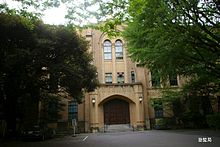
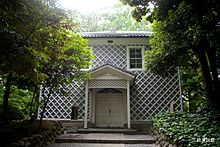

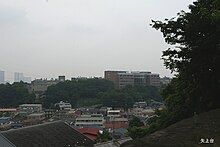
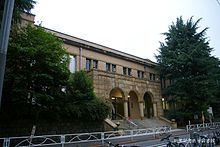

Faculties(Entrance Capacity 6404)
It has nine faculties, which cover a wide range of academic fields, with each operating independently and offering broad educational and research activities. The faculties are:
- Faculty of Letters (800)
- Faculty of Economics (1200)
- Faculty of Law (1200)
- Faculty of Business and Commerce (1000)
- School of Medicine (112)
- Faculty of Science and Technology (932)
- Faculty of Policy Management (425)
- Faculty of Environment and Information Studies (425)
- Faculty of Nursing and Medical Care (100)
- Faculty of Pharmacy (210)
- Correspondence Courses(distance learning)
Graduate Schools
- Graduate School of Letters
- Graduate School of Economics
- Graduate School of Law
- Graduate School of Human Relations
- Graduate School of Business and Commerce
- Graduate School of Medicine
- Graduate School of Science and Technology
- Graduate School of Business Administration
- Graduate School of Media and Governance
- Graduate School of Health Management
- Graduate School of Pharmaceutical Sciences
- Law School
- Graduate School of Media Design
- Graduate School of System Design and Management
Media Centers
Keio’s Media Centers, with combined holdings of over 4.58 million books and publications, are one of the largest academic information storehouses in the country.[37]
- Mita Media Center
- Hiyoshi Media Center
- Media Center for Science and Technology
- Shinanomachi Media Center
- SFC Media Center
Information Technology Centers
- ITC Headquarters
- Mita ITC
- Hiyoshi ITC
- Shinanomachi ITC
- Science & Technology ITC
- Shonan Fujisawa ITC
Affiliated Schools
- Keio Yochisha Elementary School
- Keio Futsubu School (Boys Junior High School)
- Keio Chutobu Junior High School
- Keio Shonan Fujisawa Junior and Senior High School
- Keio Senior High School
- Keio Shiki Senior High School
- Keio Girls Senior High School
- Keio Academy of New York (High School)
Language Education
- Japanese Language Program
- Keio Foreign Language School
Others
- Keio Marunouchi City Campus (KMCC)
Hospital and Rehabilitation Center
Keio University Hospital is one of the largest and best known general hospitals in Japan and is also a prestigious teaching hospital. Established in 1920, it has over 1,000 beds, a cutting-edge laboratory, and research and medical information divisions.[9]
- Keio University Hospital (慶應義塾大学病院 or 慶應大学病院)
- Tsukigase Rehabilitation Center (月が瀬リハビリテーションセンター)
Campuses
It has eleven campuses.
- Mita Campus (Mita, Minato ward, Tokyo)
- Hiyoshi Campus (Yokohama, Kanagawa)
- Yagami Campus (Yokohama, Kanagawa)
- Shinanomachi Campus (Shinjuku)
- Shonan Fujisawa Campus (Fujisawa, Kanagawa, aka SFC) designed by Fumihiko Maki
- Shiba Kyoritsu Campus (Minato ward, Tokyo)
- Shin-Kawasaki Town Campus (Kawasaki, Kanagawa)
- Tsuruoka Town Campus of Keio (Tsuruoka, Yamagata, aka TTCK)
- Urawa Kyoritsu Campus (Urawa, Saitama)
- Keio Osaka Riverside Campus (Osaka)
- Keio Marunouchi City Campus (Tokyo)
Professors
Current professors
- Heizō Takenaka, former Japanese Minister of Internal Affairs and Communications
- Jun Murai, founder of JUNET and president of WIDE University
- Hiroshi Shimizu, project leader of Eliica project (Electric Lithium-Ion Car)
- Hideo Saito, project leader of Technology to Display 3D Contents into Free Space
- Shirō Asano, former governor of Miyagi
- Takayuki Tatsumi, science fiction scholar
- Kazuhito Ikeo, the Bank of Japan's Policy Board nominated
Former professors
- Kafū Nagai, Member of Japan Art Academy, Order of Culture
- Shinobu Orikuchi, Ethnologist
- Kitasato Shibasaburō, nominated for Nobel Prize
- Ryogo Kubo, the Boltzmann Medal, Order of Culture
- Joseph E. Stiglitz, Professor of Columbia University, Nobel Prize in Economics (visiting professor)
- James Cousins, Professor of English Literature, Irish Poet, nominated for Nobel Prize
- John Henry Wigmore.[38]
Academic Rankings
| T. Reuters National[39] | Research | 10 | |
|---|---|---|---|
| WE National[40] | Employment | 3 | |
| NBP Greater Tokyo[41][42] | Reputation | 3 | |
| Shimano National[43] | Selectivity | SA | |
| QS Asia (Asia version)[44] | General | 23 | |
| ARWU Asia[45] | Research | 27-43 | |
| QS World[46] | General | 206 | |
| ARWU World[45] | Research | 201-300 | |
| ENSMP World[47] | Alumni | 3 | |
| Social Sciences & Humanities | |||
|---|---|---|---|
LAW | |||
| Asahi National[48] | Research | 2 | |
| Natural Sciences & Technology | |||
Engineering | |||
Keio University is one of the most prestigious universities in Japan . It can be seen in the following rankings.
General Rankings
The university has been ranked 2nd during 2007-2010 in the ranking called "Truly Strong Universities(本当に強い大学)" by Toyo Keizai.[54] In another ranking, Japanese prep school Kawaijuku ranked Keio as the 6th best university in Japan.[55]
It was ranked 142nd in the world by Times Higher Education World University Rankings (2009).[56] In its Asian University Ranking (2010), Quacquarelli Symonds also ranked Keio as 23rd in Asia.[44] The Academic Ranking of World Universities (2010), which is compiled by Shanghai Jiao Tong University, ranks Keio 201-300 in the world and 27-43 in Asia.[45]
Research Performance
Generally speaking, National Universities in Japan have better research standards, however Keio is one of the few Private Universities which compete with top National Universities. According to Thomson Reuters, Keio is the 10th best research university in Japan, and it's the only private university within Top 15.[39] In addition, Weekly Diamond reported that Keio has the 8th highest research standard in Japan in terms of research fundings per researchers in COE Program, and it's also the only private university within Top 10.[57]
Keio especially shows a high research standard in Materials science. According to Thomson Reuters, Keio is the 3rd best university in Japan in terms of citations per paper in Materials Science during 2005-2009.[58] It was also ranked within top 7 in Neuroscience, Clinical medicine, Biology and Biochemistry, within top 10 in Molecular biology, Genetics, Psychiatry, Psychiatry, Psychology, Social Sciences, and Humanities in terms of citation per paper surveyed by National Institute of Informatics and Thomson Reuters during 2002 and 2006.[59] Asahi Shimbun summarized the amount of academic papers in Japanese major legal journals by university, and Keio was ranked 2nd during 2005-2009.[48]
Keio is also a leading university in Economics. According to Asahi Shimbun, Keio's been ranked 7th in Japan in the economic research ranking during 2005-2009.[60] More recently, Repec in Jan 2011 ranked Keio's Economic department as Japan's 6th best economic research university.[61] Keio has provided 3 presidents of Japanese Economic Association in its 42 year history, and this number is 5th largest.[62]
In addition, Nikkei Shimbun on 2004/2/16 surveyed about the research standards in Engineering studies based on Thomson Reuters, Grants in Aid for Scientific Research and questionnaires to heads of 93 leading Japanese Research Centers, and Keio was placed 8th (research planning ability 4th/informative ability of research outcome 3rd) in this ranking.[63]
Moreover, Keio has the largest asset size of patents among Japanese universities.[64]
Graduate school Rankings
Keio Business School is Japan's earliest business school and one of only two Japanese business schools receiving a certification from The Association to Advance Collegiate Schools of Business (AACSB).[65] It is ranked No. 1 in Japan by Nikkei Shimbun.[66] Eduniversal also ranked Japanese business schools and Keio was top in Japan (75th in the world).[67] In this ranking, Keio is one of 3 Japanese business schools categorized in "Universal Business schools with major international influence".
Keio Law School is considered as one of the top Japanese law schools, as Keio's pass rate for bar exam in 2010 was top (and 6th in 2009) in Japan. [68]
Alumni Rankings
Keio has an unique alumni organization called Mita-Kai and it has a strong solidarity and massive influence in Japanese industries.[69] It represents the strongest advantage and characteristic of this university.
According to the Weekly Economist's 2010 rankings and the PRESIDENT's article on 2006/10/16, graduates from Keio University have the 3rd best employment rate in 400 major companies, and the alumni's average salary is the 3rd best in Japan.[70][71] École des Mines de Paris ranks Keio University as 3rd in the world in 2011 in terms of the number of alumni listed among CEOs in the 500 largest worldwide companies.[47] The university is also ranked 1st in Japan for the number of alumni holding the position of executive in the listed companies of Japan, and this number per student (probability of becoming an executive) is also top.[58][72]
Keio has been influential in Japanese medical societies as well. In fact, there have been 4 presidents of Japan Medical Association related to this university (2 Alumni and 2 professors).[73] This number is the 2nd largest among Japanese medical schools.[74] Keio is one of 2 Japanese universities which provided a president of World Medical Association.[75]
For over 30 years, Keio graduates have been ranked first in Japan in the number of successful national CPA exam applicants.[9] Furthermore, the number of Members of Parliament who graduated Keio has been 3rd in Japan.[76][60]
Popularity and Selectivity
Keio is a popular university in Japan. The number of applicants per place was 11.7(48260/4098) in the 2011 undergraduate admissions.[77] its entrance difficulty is usually considered as top with Waseda among 730 private universities.[78][79][80]
Nikkei BP has been publishing a ranking system called "Brand rankings of Japanese universities" every year, composed by the various indications related to the power of brand, and Keio was top in 2009 and 3rd in 2010 in Greater Tokyo Area.[81][41]
The 4ICU ranking, which evaluates universities by web popularity instead of quality of education, classifies Keio as 1st in Japan, 2nd in Asia and 14th in the world.[82][83][84] Webometrics (2008) also ranks Keio University as 3rd in Japan, 11th in Asia, and 208th in the world for quantity and quality of web presence and link visibility.[85]
In an unique ranking, TBS ranked Japanese universities by the questionnaire of "Which university student do you want to have as your boyfriend?" to 300 girls in Shibuya, and Keio was ranked 1st in this ranking .[86]
Alumni
Some of the prominent Keio alumni include: Japanese Prime Minister Junichiro Koizumi (2001–2006), Japanese Prime Minister Ryutaro Hashimoto (1996–1998), and Japanese Prime Minister Inukai Tsuyoshi. Dozens of other alumni have been cabinet members and governors in the post-war period.[87] Its alumni include 230 CEOs of major companies and 97 CEOs of foreign affiliated companies (both highest in Japan).[9] Keio has over 320,000 alumni in 866 alumni associations.[9][88]
Politicians



- Junichiro Koizumi, Former (2001–2006) Prime Minister of Japan, President of Liberal Democratic Party of Japan (Economics 1967)
- Ryutaro Hashimoto, Former (1996–1998) Prime Minister of Japan (Law 1960)
- Inukai Tsuyoshi, Former (1931–1932) Prime Minister of Japan
- Ichirō Ozawa, Former President of Democratic Party of Japan, Former Secretary General of Liberal Democratic Party of Japan (Economics 1967)
- Tamisuke Watanuki, President of People's New Party, Former Speaker of The House of Representatives of Japan (Economics 1950)
- Kenji Kosaka, Minister of Education, Culture, Sports, Science and Technology (Law 1968)
- Jirō Kawasaki, Minister of Health, Labour and Welfare (Business and Commerce 1971)
- Andrew Thomson, Minister for Sport and Tourism and Minister Assisting the Prime Minister for the Sydney 2000 Games in the Australian Government 1997 - 1998
- Shigefumi Matsuzawa, Governor of Kanagawa (Law 1982)
- Akihiko Noro, Governor of Mie (Science and Technology 1969)
- Daijiro Yamashita, Governor of Kochi (Economics 1970 and Law 1972)
- Genjirō Kaneko, Governor of Nagasaki (Letters 1968)
- Hiroshi Nakai, Chairman of the National Commission on Public Safety, Minister of State for Disaster Management and the Abduction Issue (Economics 1969)
- Yūzan Fujita, Governor of Hiroshima (Business and Commerce 1972)
- Keiichi Inamine, Governor of Okinawa (Economics 1957)
- Ichiro Fujisaki, Chairman of Executive Committee of United Nations High Commissioner for Refugees (Law Dropout 1969)
- Shinichi Kitajima, Permanent Representative of Japan to the OECD (Economics 1971)
- Masaharu Ikuta, President of Japan Post, Former CEO of Mitsui O.S.K. Lines (Economics 1957)
- Atsushi Saito, CEO and President of Industrial Revitalization Corporation of Japan (Business & Commerce 1963)
- Hideo Shinozaki, Director General of National Institute of Public Health (Medicine)
- Toru Kawajiri, President of The National Institute for Defense Studies (Economics 1973)
- Inukai Tsuyoshi, the 29th Prime Minister of Japan, leader of Rikken Seiyukai
- Yukio Ozaki, "Father of parliamentary politics" in Japan.[89]
- Nobuteru Ishihara, Minister of Land, Infrastructure and Transport, Minister of State for Administrative and Regulatory Reform, Candidate for the LDP presidency 2008
- Hirofumi Nakasone, Minister for Foreign Affairs
- Masajūrō Shiokawa, Minister of Finances, Minister of Education and Chief Cabinet Secretary
- Hidenao Nakagawa, Chief Cabinet Secretary
- Mitsuo Horiuchi, Minister of International Trade and Industry
- Yoshiyuki Kamei, Minister of Agriculture, Forestry and Fisheries
- Ryu Shionoya, Minister of Education, Science and Technology
- Shigeru Ishiba, Minister of Defense, Minister of Agriculture, Forestry and Fisheries
- Kazuyoshi Kaneko, Minister of Land, Infrastructure, Transport and Tourism and Minister for Ocean Policy
- Takeo Kawamura, Minister of Education, Science and Technology and Chief Cabinet Secretary
- Akira Amari, Minister of Economy, Trade and Industry and Minister of State in charge of Administrative Reform
- Tatsuya Ito, Minister of State for Financial Services
- Tadamori Oshima, Minister of Agriculture
- Takeo Hiranuma, Minister of Transport and Minister of Economy, Trade, and Industry
- Akira Nagatsuma, Minister of Health, Labour and Welfare, Minister of State for Pension Reform
- Masajuro Shiokawa, Chief Cabinet Secretary of Japan
Finance
- Taizo Nishimuro, Chairman and CEO of Tokyo Stock Exchange, Former CEO of Toshiba Corporation (Economics 1961)
- Toshio Ando, Chairman of Japan Securities Dealers Association, Chairman of Nomura Asset Management (Law 1974)
- Shigeharu Suzuki, President and CEO of Daiwa Securities Group (Economics 1971)
- Junichi Arimura, President and CEO of Nikko Cordial Corporation (Business and Commerce 1973)
- Toshiaki Ito, CEO and President of JAFCO (Law 1971)
- Masanori Mochida, President of Goldman Sachs Japan (Economics)
- Kensuke Hotta, Chairman of Morgan Stanley Japan (Economics)
- Haruyasu Asakura, Managing Director and Head of Japan Growth Capital team of Carlyle Group (Science and Technology)
- Taisuke Sasanuma, Founder and Representative Partner of Advantage Partners (Law, MBA)
- Shigetoshi Yoshihara, Governor of the Bank of Japan
- Shigeharu Suzkui, President and CEO of Daiwa Securities Group[citation needed]
Media
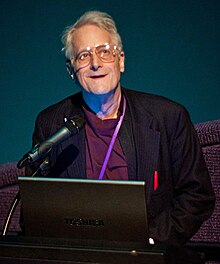
- Shoichi Ueno, owner of The Asahi Shimbun (Law 1958)
- Tōru Shōriki, owner of The Yomiuri Shimbun (Economics 1942)
- Takuo Takihana, president of The Yomiuri Shimbun (Law 1963)
- Takehiko Kiyohara, chairman of The Sankei Shimbun (Law 1962)
- Nagayoshi Sumida, president of The Sankei Shimbun (Economics 1969)
- Michisada Hirose, chairman of The National Association of Commercial Broadcasting in Japan, Chairman of the Board of TV Asahi Corporation (Law 1958)
- Shintaro Kubo, president of Nippon Television Network (Economics 1968)
- Yukio Sunahara, chairman and CEO of Tokyo Broadcasting System (Letters 1961)
Other business people
- Akio Toyoda President and CEO Toyota Motor Corporation 2009-current
- Yutaka Asoh, later to be known as Yutaka Katayama, the first president of the U.S. operations of Nissan Motors (Economics 1935)
- Kakutaro Kitashiro, Leader of Japan Association of Corporate Executives, Chairman of IBM Japan (Science and Technology 1967)
- Katsuaki Watanabe, President of Toyota Motor Corporation (Economics 1964).[90]
- Yuzaburo Mogi, Chairman and CEO of Kikkoman Corporation (Law 1958)
- Takashi Ushiku, President and COO of Kikkoman Corporation (Economics 1963)
- Shinzo Maeda, President and CEO of Shiseido (Letters 1970)
- Kazuyasu Kato, President of Kirin Brewery (Business and Commerce 1968)
- Yoji Ohashi, Chairman of the Board of All Nippon Airways (Law 1964)
- Shinji Yamamoto, Partner and Head of Bain and Company Japan (Economics 1982)
- Yoshiaki Sakito, President of Apple Computer Japan (Master Science and Technology 1983)
- Yoshio Nakamura, Acting Director General of Japan Business Federation
- Ichizō Kobayashi, Founder of Hankyu Railway and the Takarazuka Revue, Minister of Commerce and Industry in the 1940 Konoe Cabinet
- Fusanosuke Kuhara
- Nobutada Saji, Chief executive of Suntory Ltd.
- Toshio Kagami, CEO of Oriental Land Company
- Ikuo Nakagawa, CEO of Konica Minolta Danka Imaging
- Takao Kusakari, Chairman, Nippon Yusen Kaisha (NYK Line)
- Yoshiharu Fukuhara, Honorary Chairman of Shiseido Co., Ltd., and Director of Tokyo Metropolitan Museum of Photography
- Masamichi Toyama, Chairman of Smiles Co., Ltd.
- Yoshitoshi Kitajima, President of Dai Nippon Printing Company, Ltd.
Entertainment
- Nakata Atsuhiko, comedian/actor, (Economics)
- Ryo Fukawa, comedian (Economics)
- Yo Hitoto, singer (Environmental Studies)
- Ichikawa Ennosuke III, kabuki actor
- Yujiro Ishihara, actor (Dropout)
- Koji Ishizaka, actor
- Koide Keisuke, actor, (Literature)
- Takahiro Konagawa, musician, member of band, Charcoal Filter (Dropout)
- Asami Konno, singer, former member of group, Morning Musume (Currently attending), (Environmental Studies, admission office)
- Misako Konno, actress, Ambassadress of United Nations Development Programme
- Kreva, singer, member of Kick the Can Crew
- Takashi Matsumoto, lyricist, former member of Happy End
- Masataka Matsutoya, music producer
- Hiro Mizushima, actor (majoring Policy)
- Hiroshi Ōnogi, a screenwriter and novelist focused on anime productions
- Haruhiko Mikimoto an anime character designer, illustrator and manga artist
- Yusuke Miyazaki, musician (keyboardist/pianist)
- Kōyū Ohara, film director
- Sho Sakurai, singer, actor, newscaster, member of group Arashi (Economics)
- Koide Keisuke, actor (majoring in Literature)
- Hiromi Sakimoto, actor, singer, entertainment (Law)
- Koji Suzuki, horror author, author of Ring
- Mariya Takeuchi, musician (Literature, Dropout)
- Tigarah, Baile Funk emcee
- Kajirō Yamamoto, film director
- Fumi Yoshinaga, mangaka
- Yujiro, actor, television entertainer, Comedian
- Yukana, voice actress and singer (Law)
Art
- Rei Kawakubo, designer (founder of Comme des Garcons label)
- Yohji Yamamoto, Fashion Designer.[91]
- Shusaku Endo, Akutagawa Prize, Order of Culture (Literature)
- Daigaku Horiguchi, Poet, Translator, Member of Japan Art Academy
- Etō Jun, literary critic
- Hiroshi Aramata, Professor of Nihon University
- Sakutarō Hagiwara, Poet
- Yumeno Kyūsaku, Surrealistic detective novelist
- Kazuki Kaneshiro, Zainichi Korean novelist
Thailand
- Tarisa Watanagase (Thai), Governor of the Bank of Thailand, 2006–2010 (Economics)
- Lernchai Marakarn (Thai), Governor of the Bank of Thailand, 1996-1997 (Money and Banking)
- Sommai Hoontrakool (Thai), Minister of Finance of Thailand, 1982-1986 (Economics)
Others
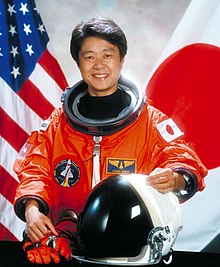
- Yusuke Amimori, gamer (Economics)
- Takeshi Fukuzawa, Executive Counsel, Mitsubishi Real Estate (Law)
- Akihiko Hoshide, JAXA astronaut
- Shichiro Ishikawa, president of the International Association for the Study of Lung Cancer
- Chiaki Mukai, surgeon and astronaut
- Zheng Nanning, president of Xi'an Jiaotong University, China (PhD, Engineering)
- Theodor Holm "Ted" Nelson, Computer architect, visionary, and contrarian (PhD, Media and Governance, 2002)
- Isao Obata, Shotokan karate master
- Ken Sakamura, professor of University of Tokyo, creator of TRON, Takeda Award (Engineering)
- Sosuke Sumitani, announcer (Economics)
- Tsunekazu Takeda, chairman of Japanese Olympic Committee (Law 1970)
- Taro Takemi, president of the World Medical Association and Japan Medical Association
- Yoshio Taniguchi, architect (Mechanical Engineering)
- Hiromoto Watanabe, first president of the Imperial University (now The University of Tokyo)
See also
- Keio Medical Science Prize
- Keio Media Centers (Libraries)
- Eliica
- Auto-ID Labs
- Keio University Shonan Fujisawa Campus
- Keio Shonan-Fujisawa Junior & Senior High School
- Sakura Tsushin ("Sakura Diaries"), a manga and anime series by U-jin which prominently features Keio University.
- Japanese University Ranking
- List of National Treasures of Japan (crafts-others)
Gallery
-
Previous South building on Mita Campus
Sources
References
- ^ http://www.keio.ac.jp/ja/about_keio/data/faculty_and_staff.html
- ^ http://www.keio.ac.jp/ja/about_keio/data/faculty_and_staff.html
- ^ Okun, Stanley. "For Japanese in U.S., School, Japanese Style," New York Times. February 1, 1988.
- ^ Junichiro Koizumi (2001–2006), Ryutaro Hashimoto (1996–1998), and Inukai Tsuyoshi (1931-1932)
- ^ [1]
- ^ http://keio150.jp/english/ceremony/img/05.pdf
- ^ http://www.w3.org/Press/Keio-PR.html
- ^ http://www.g30.keio.ac.jp/about_g30.html
- ^ a b c d e http://www.ogi.keio.ac.jp/english/Keio-University-pamphlet.pdf
- ^ a b http://www.keio.ac.jp/ja/contents/mamehyakka/53.html
- ^ In Edo Period, the private schools normally collected money or properties with Noshi irregularly from students, but those fees highly depend on each student's economic circumstance. Fukuzawa thought such unstable financial system prevents modernization of educational institution and professors' professionalism. Then he designed a rudimentary management system for the school finance.[2]
- ^ Before Meiji Period, Japanese people had thought the oral statement is not reliable enough for decision making, thus every time people had needed to state their opinions on paper when they had needed to decide something. Fukuzawa thought this culture would seriously prevent to introduce the modern parliamentary regime and the fair court system. Then he developed the art of speech by the arrangement of Western speech. [3]
- ^ http://www.keio.ac.jp/ja/contents/mamehyakka/41.html
- ^ http://www.keio.ac.jp/ja/contents/mamehyakka/60.html
- ^ In fact, this phrase was also used for his Dharma name, which is a given name when people are dead, representing their nature.
- ^ http://www.keio.ac.jp/ja/contents/mamehyakka/16.html
- ^ Japanese people usually use "Kun" only between friends. This expression is normally considered as an informal expression and shouldn't be used for professors.
- ^ Keio only use the honorific of "Teacher" or "Professors" officially when they refer Fukuzawa's name.
- ^ http://www.keio.ac.jp/ja/contents/mamehyakka/36.html
- ^ 島田 裕巳 "慶應三田会―組織とその全貌" 三修社
- ^ "慶應義塾豆百科〕No.4 慶應義塾の起源" (in Japanese). Keio University.
- ^ Although Shinshu Kan didn't have a direct relation to Keio, Many people who studied or managed there were involved with Keio later. In fact, all students from Nakatsu Domain moved to Keio when it was closed.
- ^ 1868 is 4th year of Keio
- ^ "慶應義塾豆百科〕No.7 塾名の由来" (in Japanese). Keio University.
- ^ Although Keio had been already involved to the higher education, it had not had a university system before 1890. It was authorized by Japanese government as a university in 1920.
- ^ See ja:慶應義塾大学 for detail
- ^ http://www.keio.ac.jp/english/keio_in_depth/keio_view/001.html
- ^ It is usually regarded as one of the most prestigious academic journals in the world
- ^ http://www.st.keio.ac.jp/english/news/20060317_01.html
- ^ http://www.st.keio.ac.jp/news/20060316_001.html
- ^ McGraw, John J. "Americans Defeat Great Jap Pitcher; Sugase, Idolized at Keio University, Easy for Giants and White Sox," New York Times. December 8, 1913.
- ^ "Michigan Nine, Touring Japan, Loses to Keio University, 2-1," New York Times. September 11, 1932.
- ^ 橘木 俊詔 "早稲田と慶応 名門私大の栄光と影" 講談社 2008
- ^ "早稲田と慶応義塾―人気・実力・スポーツどちらが上か" マガジンハウス 1996
- ^ 三田英彬 "早稲田・慶応どちらが損か得か" 山手書房 1980
- ^ "東京の大学―早稲田慶応" 河出新書 1956
- ^ This number is 5th in Japan in 2008.[4]
- ^ "Edits Japanese Law Data; Prof. Wigmore Completing Work on Records of 1600-1860," New York Times. June 23, 1935.
- ^ a b "Thomson Reuters 20 Top research institutions in Japan". Thomson Reuters. 2011. Retrieved July 22, 2022. (this raking includes 5 non-educational institutions)
- ^ "Employment rate in 400 major companies rankings" (in Japanese). Weekly Economist. 2011. Retrieved April 29, 2011.
- ^ a b "Nikkei BP Brand rankings of Japanese universities" (in Japanese). Nikkei Business Publications. 2010. Retrieved April 29, 2011.
- ^ "Nikkei BP Brand rankings of Japanese universities" (in Japanese). Nikkei Business Publications. 2009. Retrieved April 29, 2011.
- ^ "GBUDU University Rankings" (in Japanese). YELL books. 2009. Retrieved April 29, 2011.
- ^ a b "QS Asian University Rankings". QS Quacquarelli Symonds Limited. 2023. Retrieved November 8, 2023.
- ^ a b c "Academic Ranking of World Universities". Institute of Higher Education, Shanghai Jiao Tong University. 2024. Retrieved August 15, 2024.
- ^ "QS World University Rankings". QS Quacquarelli Symonds Limited. 2025. Retrieved June 4, 2024.
- ^ a b "ENSMP World University Rankings" (PDF). École nationale supérieure des mines de Paris. 2011. Retrieved April 29, 2011.
- ^ a b Asahi Shimbun University rankings 2010 "Publification rankings in Law (Page 4)" (PDF) (in Japanese). Asahi Shimbun. 2010. Retrieved May 11, 2011.
- ^ "Kawaijuku japanese universities rankings in Engineering field" (in Japanese). Kawaijuku. 2012. Retrieved July 20, 2012.
- ^ "QS topuniversities world rankings in Engineering field". Topuniversities. 2012. Retrieved July 20, 2012.
- ^ a b c d e f g h i j k l "Thomson Reuters 10 Top research institutions by subject in Japan" (in Japanese). Thomson Reuters. 2010. Retrieved May 11, 2011.
- ^ a b "ARWU in Mathematics". Shanghai Jiaotong University. 2011. Retrieved May 11, 2011.
- ^ a b "ARWU in Computer Science". Shanghai Jiaotong University. 2010. Retrieved May 11, 2011.
- ^ http://www.toyokeizai.net/business/industrial/detail/AC/7ca97f085eda34ce139f6d1210cef898/page/1/
- ^ Cite error: The named reference
Rankings_Kawai_Nwas invoked but never defined (see the help page). - ^ http://www.topuniversities.com/university-rankings/world-university-rankings/2009
- ^ "週刊ダイヤモンド" ダイヤモンド社 2010/2/27 http://web.sapmed.ac.jp/kikaku/infomation/0227daiyamondokiji.pdf
- ^ a b [http:
http://researchanalytics.thomsonreuters.com/grr/grr-japan/ "Thomson Reuters High Impact Institutions in Materials and Space Sciences in Japan"]. Thomson Reuters.
{{cite web}}: Check|url=value (help); Cite has empty unknown parameter:|1=(help); line feed character in|url=at position 6 (help) (this raking includes non-educational institutions) Cite error: The named reference "executive" was defined multiple times with different content (see the help page). - ^ "大学ランキング2009" (in Japanese). Asahi Shimbun.
- ^ a b "University rankings 2011" Asahi Shinbun
- ^ http://ideas.repec.org/top/old/1101/top.japan.html
- ^ http://www.jeaweb.org/eng/AboutPresidents.html
- ^ http://homepage3.nifty.com/katu-kobayashi/doppo/kougaku_kennkyu.htm
- ^ http://www.admissions.keio.ac.jp/gb/dbook/2011/gb/index.html?highlightwords=%E6%85%B6%E6%87%89%E7%BE%A9%E5%A1%BE%E5%A4%A7%E5%AD%A6%2C%E7%89%B9%E8%A8%B1%E8%B3%87%E7%94%A3#page=21
- ^ https://www.aacsb.net/eweb/DynamicPage.aspx?Site=AACSB&WebKey=00E50DA9-8BB0-4A32-B7F7-0A92E98DF5C6
- ^ http://www.ics.hit-u.ac.jp/community/inthenews.html
- ^ http://www.eduniversal-ranking.com/business-school-university-ranking-in-japan.html
- ^ http://laws.shikakuseek.com/data/2010data-2.html
- ^ 島田 裕巳 "慶應三田会―組織とその全貌" 三修社
- ^ http://www2.ttcn.ne.jp/honkawa/3865.html
- ^ http://hensachi-ranking.seesaa.net/article/26733115.html#more
- ^ "出身大学別上場企業役員数ランキング" (in Japanese). 大学ranking.net.
- ^ Kitasato Shibasaburō,Taichi Kitajima,Taro Takemi and Toshiro Murase
- ^ "Japan Medical Association report" (PDF) (in Japanese). Japan Medical Association.
- ^ http://www.med.or.jp/wma/
- ^ http://univranking.schoolbus.jp/00000277.htm
- ^ http://www.admissions.keio.ac.jp/exam/shigansha.html
- ^ National and Public universities apply different kind of exams. so it's only comparable between universities in a same category.
- ^ e.g. Yoyogi seminar published Hensachi (the indication showing the entrance difficulties by prep schools) rankings http://www.yozemi.ac.jp/rank/gakubu/index.html
- ^ Japanese journalist Kiyoshi Shimano ranks its entrance difficulty as SA (most selective/out of 11 scales) in Japan. "危ない大学・消える大学 2012年版" (in Japanese). YELL books. 2011.
- ^ http://consult.nikkeibp.co.jp/consult/release/ub091210a.html
- ^ [5]
- ^ [6]
- ^ [7]
- ^ [8]
- ^ TV program "Rank Okoku" on 2010/2/6 http://blogs.yahoo.co.jp/jterasaka/40927577.html
- ^ [9]
- ^ http://www.admissions.keio.ac.jp/encourage/guidefile.html
- ^ Ozaki, Yukio. (2001). The Autobiography of Ozaki Yukio: The Struggle for Constitutional Government in Japan, pp. 21-26; Encyclopedia Britannica: Ozaki Yukio.
- ^ Korea Communications Commission: OECD, Katsuaki Watanabe.
- ^ "Yoji Yamamoto," Womens Wear Daily (New York).
Bibliographie
- The Keiogijuku University: a brief account of its history, aims and equipment. Keio Gijuku University. 1912.
{{cite book}}: External link in|title=

